INTEGRAL CALCULUS BETA GAMMA FUNCTION LECTURE 16
TLDRThe video script is an in-depth tutorial on integral calculus, focusing on solving a specific problem involving knowledge and functions. The instructor welcomes viewers to the YouTube channel and encourages them to watch previous videos for context. The problem involves complex calculations, including converting the integral to standard form, applying various mathematical techniques, and solving for specific functions. The solution process is methodical, emphasizing the importance of understanding the principles of integral calculus and the application of formulas. The video aims to enhance the viewer's comprehension of advanced mathematical concepts and their practical application.
Takeaways
- 📘 The video is a tutorial on integral calculus, focusing on solving a specific problem involving knowledge and functions.
- 🔢 The problem given in the question involves calculating a great wall area and is set in the year 202, with specific mathematical expressions.
- 📌 The solution process includes converting the given integral into its standard form, which involves dealing with functions of knowledge and functions.
- 🤔 The video emphasizes the importance of understanding the standard form of integral calculus and how to convert expressions into this form for easier problem-solving.
- 🧠 The讲师 explains the concept of depression in the context of the problem, highlighting the second form of the knowledge function.
- 🔄 The video demonstrates the use of substitution and rearrangement techniques to simplify the integral and solve the problem.
- 📊 The讲师 also discusses the concept of limits in integral calculus, showing how to find the lower and upper limits for the integral.
- 👓 The solution involves the use of power rules and the concept of limits, which are crucial for solving advanced calculus problems.
- 📈 The讲师 provides a step-by-step breakdown of the solution, ensuring that viewers can follow along and understand the process.
- 🌟 The video concludes with the讲师 solving the problem and providing the final answer, reinforcing the concepts taught throughout the tutorial.
- 💡 The讲师 encourages viewers to practice and apply the techniques learned in the video to improve their understanding of integral calculus.
Q & A
What is the main topic of the video?
-The main topic of the video is solving a problem involving integral calculus and functions in a mathematical context.
What does the video suggest to do before starting the problem?
-The video suggests reviewing all previous videos in the series by visiting the description of the current video, where a playlist link will be provided for easy access.
How does the video approach the problem-solving process?
-The video approaches the problem-solving process by first converting the given integral into its standard form, then applying various mathematical techniques to simplify and solve the problem.
What is the significance of the 'Should have' and 'Given' expressions mentioned in the script?
-The 'Should have' and 'Given' expressions refer to the expected and provided integral forms, respectively, which are crucial for converting the problem into a solvable format.
What does the term 'Depression' mean in the context of the script?
-In the context of the script, 'Depression' likely refers to a mathematical function's form, specifically the second form of the integral function that needs to be evaluated.
How does the video explain the concept of limits in the context of integral calculus?
-The video explains limits by discussing how to convert the given problem into a form that allows for easy evaluation of the limits, specifically focusing on the lower and upper limits of the integral function.
What is the role of the 'Extra Elephant' in the problem-solving process?
-The 'Extra Elephant' seems to be a term used in the script to refer to an additional variable or term that is introduced during the problem-solving process, possibly to help in simplifying or evaluating the expression.
How does the video address the concept of 'Defensive' in the script?
-The term 'Defensive' in the script likely refers to a step or technique used to simplify the problem or to address a specific challenge within the integral calculus process.
What is the significance of the 'Root' mentioned in the script?
-The 'Root' mentioned in the script is likely a mathematical concept used to simplify the integral expression or to find the value of the function at a particular point.
How does the video conclude the problem-solving process?
-The video concludes the problem-solving process by verifying that the final result matches the expected outcome, ensuring that all steps have been correctly applied, and providing a clear solution to the problem.
Outlines
📘 Introduction to Integral Calculus
The video begins with a warm welcome to the audience on the YouTube channel, focusing on Integral Calculus. The first problem of knowledge and function is solved, highlighting the process of solving integral calculus. The video encourages viewers to watch previous videos for context and introduces the concept of solving a problem in integral calculus, emphasizing the importance of understanding the standard form of integral and function.
🔢 Dealing with Integral Limitations
The second paragraph delves into the specifics of handling limitations in integral calculus. It discusses the process of converting the given integral into a standard form and solving it using previously used methods. The paragraph also explains how to deal with the left-hand side of the equation and the concept of limits, providing a detailed walkthrough of the steps involved in solving the integral calculus problem.
🔄 Integrating and Simplifying Expressions
This section focuses on the integration process, simplifying expressions, and solving complex problems in integral calculus. It explains the technique of replacing certain elements in the equation to simplify the problem and illustrates how to deal with different types of limits, such as lower and upper limits, in the context of integral calculus.
📈 Finalizing the Integral Calculation
The final paragraph wraps up the integral calculus problem by solving the remaining parts and ensuring that the solution matches the standard form of the knowledge and function. It emphasizes the importance of checking the solution against the given problem and provides a comprehensive review of the entire process, from setting up the integral to simplifying and solving the equation.
Mindmap
Keywords
💡Integral Calculus
💡Functions
💡Limits
💡Depression
💡Power Functions
💡Exponential Functions
💡Proof
💡Substitution
💡Differential
💡Root
Highlights
The video discusses integral calculus and its application to solve a specific problem involving knowledge and functions.
The problem involves calculating the integral of a function and understanding its standard form.
The video demonstrates the process of converting the given integral into its standard form for easier proofreading.
The solution process follows a technique similar to previous processes used in the video series.
The video emphasizes the importance of watching all previous videos for a comprehensive understanding of the topic.
The problem involves the concept of 'Should have a great wall' and the exclusion of certain terms in the function.
The video explains how to deal with the power of functions and their integration in the problem-solving process.
The process includes the use of the integration formula and understanding the limits of integration.
The video provides a detailed explanation of the depression function and its second form.
The solution involves the use of the power rule for integration and the concept of limits.
The video demonstrates how to simplify the integral expression and solve for the function's value.
The video explains the concept of the extra element and how to handle it in the problem-solving process.
The solution process involves the use of the chain rule and the concept of limits for integration.
The video provides a clear example of how to solve the problem by applying the knowledge and function of integral calculus.
The video concludes with a summary of the problem-solving process and the final result.
The video encourages viewers to practice the problem-solving techniques discussed for better understanding and application.
The video ends with a call to action for viewers to like, share, and subscribe for more educational content.
Transcripts
Browse More Related Video
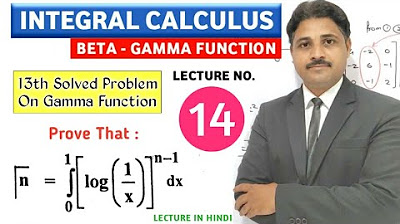
INTEGRAL CALCULUS BETA GAMMA FUNCTION LECTURE 14

INTEGRAL CALCULUS BETA GAMMA FUNCTION LECTURE 13
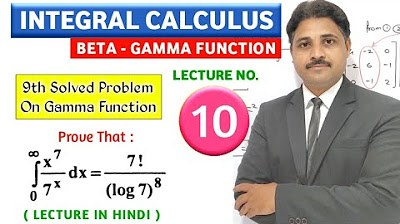
INTEGRAL CALCULUS BETA GAMMA FUNCTION LECTURE 10
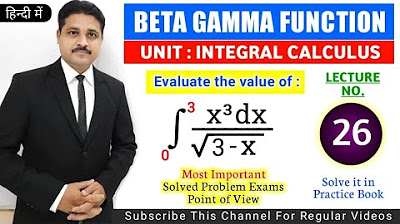
INTEGRAL CALCULUS BETA GAMMA FUNCTION LECTURE 26 | BETA GAMMA FUNCTION SOLVED PROBLEM IN HINDI
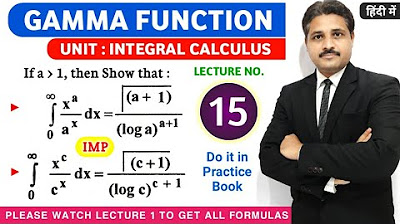
INTEGRAL CALCULUS BETA GAMMA FUNCTION LECTURE 15
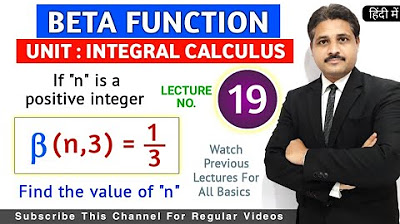
INTEGRAL CALCULUS BETA GAMMA FUNCTION LECTURE 19 | BETA FUNCTION SOLVED PROBLEM @TIKLESACADEMY
5.0 / 5 (0 votes)
Thanks for rating: